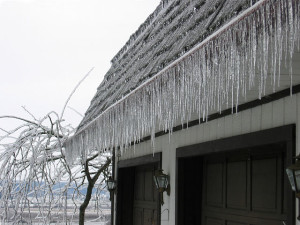09 Oct Ten Simple Steps to Winterize Your Home
Cooling temps, changing leaves, candy corn, and pumpkins herald more than just Halloween. Winter is coming, close on it’s heels. Time to ask the question: Is your home ready for winter? We’ve put together a list of ten simple steps to winterize your home, in order to help you get started in tackling an often dreaded chore.
1. Change Your Furnace Filter
Most home experts recommend changing your furnace filter on a monthly basis during the winter heating season. Not only does this keep the air quality in your home healthier, it also saves on heating costs as the air flows more freely through the furnace.
2. Reverse the Ceiling Fans
Ceiling fans should run counter-clockwise during the summer, and clockwise during the winter. A fan running clockwise will move warm air from the ceiling to the floor, cutting heating costs by up to 10%.
3. Schedule a Furnace Tune-Up
A little maintenance can go a long way, and can save up to 5% in heating costs. Take advantage of the specials that are often offered at this time of year, and schedule an HVAC technician to come out and make sure that your furnace is running at its best.
4. Install a Programmable Thermostat
Simply lowering the temperature in your home by 1 degree will save 1-3% on your energy bill, and a programmable thermostat will  automatically lower the temperature at times when your family is typically not home. A programmable thermostat will run anywhere from $30 to $250, depending on the bells and whistles. The average family can save $150 per year, which means that even the most expensive thermostat will pay for itself in a year or two.
automatically lower the temperature at times when your family is typically not home. A programmable thermostat will run anywhere from $30 to $250, depending on the bells and whistles. The average family can save $150 per year, which means that even the most expensive thermostat will pay for itself in a year or two.
5. Put Plastic on the Windows
If your windows are drafty, consider installing plastic sheeting over the worst offenders, especially those on the windward side of the house. Many people shrink away from this idea, feeling that it will look tacky. However, when plastic shrink wrap is installed correctly, you will barely notice that its there – except when you wake up one night and realize that your bedroom feels ten degrees warmer than it did before.
6. Add Caulk to Windows
According to the US Department of Energy, simple air leaks waste 5-30% of energy, so this Saturday morning project could save you a bundle, and keep you more comfortable to boot.
Unsure of where to caulk? Light a stick of incense, and move it around the edges of each window in your home (be sure to avoid curtains and other flammable objects!). Wherever the smoke waivers, you need to caulk.
7. Insulate Pipes
A burst pipe can quickly become a home disaster. Make sure that all pipes on outside walls are insulated, and, to save additional money, check all of your pipes for efficiency. Any pipe that’s warm to the touch should be insulated. Pre-slit foam insulation is available at any home improvement store, and is very easy to install. While you’re at it, check the water heater. If it’s warm to the touch, it could use some insulation as well, for which we recommend a water heater blanket.
 8. Don’t Forget the Outside
8. Don’t Forget the Outside
Be sure to disconnect all hoses and empty water from the spigots. If you have a sprinkler system, don’t forget to have the pipes blown out and winterized. Bring your clay pots inside, or turn them upside down to prevent cracking from freezing water.
9. Get a Carbon Monoxide Detector
With heaters running, the risk of carbon monoxide leaks always exists. If you don’t already have one, invest in a carbon monoxide detector to ensure that your family is safe from this odorless gas.
10. Take Advantage of Tax Breaks
Many larger home improvement projects that increase your home’s energy efficiency will save you money on your taxes, including insulating, purchasing a new furnace or windows, and more. Use this database to keep track of tax incentives available in your state. http://www.dsireusa.org/
Conclusion
Taking a little time to adequately prepare your house for the coming cold weather will save you money on heating costs, as well as help protect you from the expense of damage caused by broken pipes and leaking roofs. The precautionary measures we’ve outlined above will help guarantee a winter filled with hot cocoa and snowflakes, rather than flooded basements and high energy bills.






Preparing Your Car for Winter - Five Tips - Exact Insure
Posted at 16:09h, 17 October[…] week, we took a look at Ten Simple Steps to Winterize Your Home. This week, as we continue to brace ourselves for the upcoming winter, we’ll share some tips […]